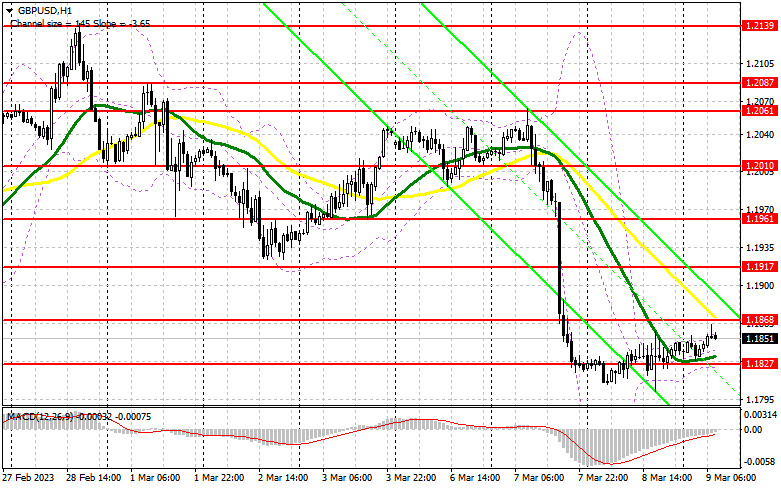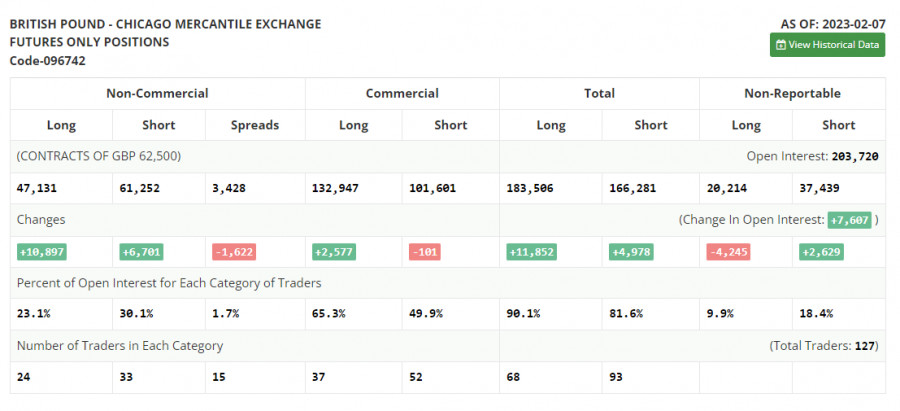
Yesterday, there was only one entry point. Now, let's look at the 5-minute chart and figure out what actually happened. In my morning article, I turned your attention to 1.1837 and recommended making decisions with this level in focus. An upward movement and a false breakout of 1.1837 led to a sell signal, which resulted in a drop of 20 pips in the afternoon. There were no entry points due to a surge in volatility in the American session.

When to open long positions on GBP/USD:
Today, the bulls might have a perfect opportunity to start a correction as there will be no crucial economic reports in the morning. However, it is better to refrain from opening long positions as the bearish sentiment is strong. One may go long only after a decrease and a false breakout of the support level of 1.1827 formed yesterday. This will give a buy signal despite the bear market with the prospect of a rise to the resistance level of 1.1868. If there is a consolidation and a downward retest of this level, GBP/USD could reach a high of 1.1917. Traders could open long positions there only after a breakout with the likelihood of growth to 1.1961. At this level, I recommend locking in profits. If the bulls fail to push the pair above 1.1827, the pressure on the pound sterling will increase. In this case, I would advise you not to rush into purchases and open long positions at the support level of 1.1785 and only on a false breakout. You could buy GBP/USD at a bounce from 1.1747, keeping in mind an upward intraday correction of 30-35 pips.
When to open short positions on GBP/USD:
Bulls will hardly be able to return the market under their control but they will definitely make an attempt to do so. Therefore, it is better to open short positions today only after a false breakout of the resistance level of 1.1868. It will provide an excellent entry point into short positions. GBP/USD is likely to drop to a low of 1.1827 where the moving averages are passing. A breakout and an upward test of this level will escalate the pressure on the pair. It will also undermine buyers' plans for an upward correction, creating a sell signal with a decrease to 1.1785. A more distant target level is located at a low of 1.1747 where I recommend locking in profits. If GBP/USD rises and bears show no energy at 1.1868, it will hardly affect the bearish trend. Yet, the upward correction will continue. In this case, the bears will retreat and only a false breakout of the resistance level of 1.1917 will give an entry point into short positions. If bears do not protect this level, you could sell GBP/USD at a bounce from 1.1961, keeping in mind a downward intraday correction of 30-35 pips.

COT report
The COT report for February 7 logged a rise in both long and short positions. Apparently, traders cheered the BoE's further policy which is why they opened new long positions. Yet, some market participants decided to sell the pound sterling while it is still rising. They expect the Fed to maintain its aggressive monetary policy. This week, the economic calendar for the UK will be uneventful. It means that pressure on risk assets may finally ease. The pound sterling could take advantage of it and start an upside correction. Markets will definitely take notice of the statement by Fed Chair Jerome Powell as he is likely to provide hints about the regulator's key rate decision at the next meeting in late March. According to the latest COT report, short positions of the non-commercial group of traders went up by 6,701 to 61,252, while long positions rose by 10,897 to 47,131. This resulted in a decline in the negative value of the non-commercial net position. It dropped to -14,121 from -18,317 recorded a week ago. The weekly closing price fell to 1.2041 from 1.2333.

Indicators' signals:
Trading is carried out near the 30 and 50 daily moving averages, which indicates sideways movement.
Moving averages
Note: The period and prices of moving averages are considered by the author on the H1 (1-hour) chart and differ from the general definition of the classic daily moving averages on the daily D1 chart.
Bollinger Bands
If GBP/USD declines, the indicator's lower border at 1.1825 will serve as support.
Description of indicators
Moving average (moving average, determines the current trend by smoothing out volatility and noise). Period 50. It is marked yellow on the chart.Moving average (moving average, determines the current trend by smoothing out volatility and noise). Period 30. It is marked green on the chart.MACD indicator (Moving Average Convergence/Divergence - convergence/divergence of moving averages) Quick EMA period 12. Slow EMA period to 26. SMA period 9Bollinger Bands (Bollinger Bands). Period 20Non-commercial speculative traders, such as individual traders, hedge funds, and large institutions that use the futures market for speculative purposes and meet certain requirements.Long non-commercial positions represent the total long open position of non-commercial traders.Short non-commercial positions represent the total short open position of non-commercial traders.Total non-commercial net position is the difference between the short and long positions of non-commercial traders.